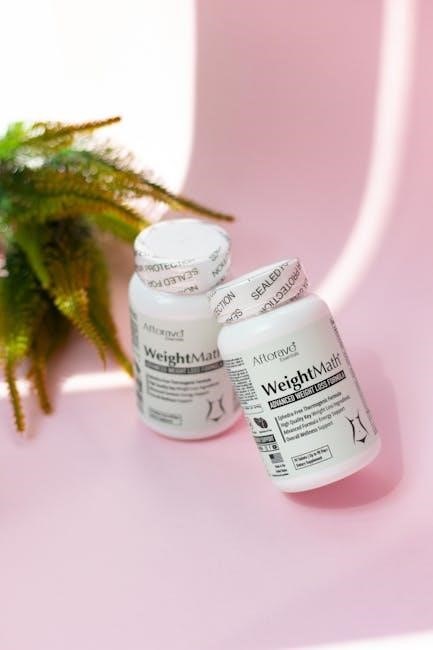
A stomach ulcer diet focuses on managing symptoms through dietary adjustments. It emphasizes avoiding irritants and incorporating nutrient-rich foods to promote healing and alleviate discomfort effectively.
1.1 Overview of Stomach Ulcers
Stomach ulcers‚ also known as peptic or gastric ulcers‚ are open sores that develop in the lining of the stomach or the upper part of the small intestine. They occur when the protective mucus layer of the stomach is damaged‚ allowing stomach acid to erode the tissue. Symptoms often include abdominal pain‚ bloating‚ heartburn‚ and indigestion. If left untreated‚ ulcers can lead to serious complications like bleeding or perforation. Stomach ulcers are a common health issue worldwide‚ affecting millions of people regardless of age‚ gender‚ or race‚ with higher prevalence among those over 60 years old. Proper management‚ including dietary changes‚ is crucial for healing and preventing recurrence.
1.2 Importance of Diet in Managing Stomach Ulcers
Diet plays a crucial role in managing stomach ulcers by reducing symptoms and promoting healing. A well-balanced diet helps minimize stomach acid production and avoids irritants that can exacerbate the condition. Foods that are gentle on the stomach‚ such as lean proteins‚ high-fiber foods‚ and probiotics‚ are recommended. Avoiding acidic‚ spicy‚ and high-fat foods can prevent further irritation. Additionally‚ eating smaller‚ more frequent meals can reduce strain on the stomach lining. By adhering to a tailored diet plan‚ individuals can alleviate discomfort‚ support the healing process‚ and prevent future ulcer development. This approach‚ combined with medical treatment‚ offers a comprehensive strategy for managing stomach ulcers effectively.

Causes and Risk Factors of Stomach Ulcers
H. pylori infection and long-term use of NSAIDs are primary causes. Stress‚ excessive alcohol‚ and genetic predisposition also increase the risk of developing stomach ulcers.
2.1 Role of H. Pylori Infection
H. pylori infection is a primary cause of stomach ulcers‚ infecting the stomach lining and causing inflammation. It disrupts the protective mucus layer‚ leading to acid imbalance and ulcer formation. While many people carry the bacteria‚ only some develop ulcers‚ suggesting host response influences severity. Eradicating H. pylori is crucial for healing and preventing recurrence. Antibiotics are often prescribed to treat the infection‚ ensuring the ulcer can heal properly. Managing H. pylori is essential for long-term recovery and reducing the risk of future ulcers. This bacterial infection remains a significant factor in peptic ulcer disease globally.
2.2 Impact of NSAIDs on Stomach Lining
Nonsteroidal anti-inflammatory drugs (NSAIDs) can severely impact the stomach lining‚ leading to ulcers. These medications inhibit the production of prostaglandins‚ which protect the stomach by maintaining its mucus barrier. Without this protection‚ stomach acid can erode the lining‚ causing pain and bleeding. Long-term NSAID use is a common cause of peptic ulcers‚ particularly in individuals over 60 or those with a history of gastrointestinal issues. Discontinuing NSAIDs or switching to alternative pain relievers under medical guidance is often necessary for healing. A stomach ulcer diet may help mitigate damage‚ but addressing NSAID use is critical for recovery and preventing recurrence.
2.3 Stress and Its Effects on Digestive Health
Stress significantly impacts digestive health and can exacerbate stomach ulcers. When stressed‚ the body releases hormones like cortisol‚ which can increase stomach acid production and reduce blood flow to the stomach lining. This imbalance can weaken the protective mucus barrier‚ making the stomach more susceptible to ulcers. Chronic stress also slows digestion‚ allowing acid to linger in the stomach‚ further irritating the lining. Managing stress through techniques like meditation‚ yoga‚ or deep breathing can help reduce acid production and promote healing. Incorporating stress management into a stomach ulcer diet plan is essential for overall digestive well-being and preventing flare-ups.
Foods to Avoid in Stomach Ulcer Diet
Stress increases stomach acid production‚ weakening the stomach lining and worsening ulcers. Managing stress through relaxation techniques can reduce acid secretion and aid healing.
3.1 Acidic Foods and Their Role in Exacerbating Symptoms
Acidic foods‚ such as citrus fruits‚ tomatoes‚ and vinegar-based products‚ can irritate the stomach lining‚ worsening ulcer symptoms. These foods increase stomach acid production‚ which can exacerbate pain and discomfort. Avoiding or limiting acidic foods helps reduce irritation and promotes healing. Opting for non-acidic alternatives‚ like bananas or melons instead of oranges‚ can alleviate symptoms. Additionally‚ processed foods and sauces high in acidity should be avoided to prevent further irritation. Monitoring how these foods affect symptoms is crucial‚ as individual tolerance may vary. Balancing the diet with less acidic options supports the healing process and reduces discomfort for those managing stomach ulcers.
3.2 Spicy Foods and Their Impact on Stomach Lining
Spicy foods can significantly irritate the stomach lining‚ exacerbating ulcer symptoms. The capsaicin in chili peppers can heighten discomfort and pain for individuals with ulcers. While some may tolerate mild spices‚ excessive heat can delay healing. Choosing bland or mild alternatives is advisable. Overconsumption of spicy dishes can lead to prolonged irritation‚ hindering recovery. It is beneficial to gradually reintroduce spices after healing to assess tolerance. Prioritizing gentle flavors supports a smoother recovery and reduces the risk of symptom flare-ups. A cautious approach to spicy foods is essential for effective ulcer management and overall digestive health.
3.3 Caffeine and Alcohol Consumption Guidelines
Caffeine and alcohol can exacerbate stomach ulcer symptoms by irritating the stomach lining. Caffeine‚ particularly in coffee‚ can stimulate acid production‚ worsening discomfort. Alcohol‚ a known irritant‚ can impede healing and should be consumed in moderation or avoided entirely. Both substances can delay recovery and increase the risk of complications. It is advisable to limit or avoid these beverages to reduce symptom severity and promote healing. Consulting a healthcare provider can help determine safe consumption levels‚ as sensitivity varies among individuals. Reducing or eliminating caffeine and alcohol intake is often recommended to support an effective stomach ulcer management plan.

Recommended Foods for Stomach Ulcer Healing
A diet rich in whole grains‚ lean proteins‚ and non-acidic fruits and vegetables supports healing. Probiotic-rich foods like yogurt and fermented vegetables also promote gut health and recovery.
4.1 High-Fiber Foods and Their Benefits
High-fiber foods play a crucial role in managing stomach ulcers by reducing inflammation and promoting healing. Foods like whole grains‚ fruits‚ vegetables‚ and legumes are rich in fiber‚ which helps absorb excess acid and protect the stomach lining. A high-fiber diet can also improve digestion and reduce symptoms like bloating and discomfort. Additionally‚ fiber supports the growth of beneficial gut bacteria‚ enhancing overall digestive health. Incorporating fiber-rich foods into meals helps create a protective barrier against acid‚ aiding in the recovery of the stomach lining and preventing further irritation. This makes high-fiber foods an essential component of a stomach ulcer diet‚ supporting both healing and long-term digestive well-being.
4.2 Probiotic-Rich Foods for Gut Health
Probiotic-rich foods are essential for maintaining gut health‚ particularly for individuals with stomach ulcers. These foods contain live bacteria that support the balance of the digestive system‚ reducing inflammation and aiding in the healing of the stomach lining. Yogurt‚ kefir‚ sauerkraut‚ and kimchi are excellent sources of probiotics. They help combat harmful bacteria‚ such as H. pylori‚ which can cause ulcers. Probiotics also enhance the absorption of nutrients and strengthen the immune system. Incorporating probiotic-rich foods into the diet can alleviate symptoms like bloating and discomfort‚ promoting a faster recovery. They are a natural and effective way to support gut health and overall well-being for those managing stomach ulcers.
4.3 Lean Proteins and Their Role in Recovery
Lean proteins play a crucial role in the recovery process for individuals with stomach ulcers. Foods such as poultry‚ fish‚ tofu‚ and legumes are excellent sources of lean protein that help repair tissues and maintain muscle mass without irritating the stomach lining. Unlike processed or fatty meats‚ these options are easier to digest and reduce the risk of triggering discomfort. Incorporating lean proteins into the diet supports overall health and aids in healing the ulcerated areas. They also provide essential nutrients like zinc and iron‚ which are vital for immune function and energy levels. Choosing lean proteins ensures a balanced and gentle diet‚ promoting a smoother recovery and reducing the risk of complications.

Lifestyle Modifications for Ulcer Management
Lifestyle changes‚ such as quitting smoking‚ managing stress‚ and avoiding alcohol‚ can significantly reduce stomach acid production and aid in ulcer healing and symptom relief.
5.1 Smoking Cessation to Reduce Stomach Acid
Smoking cessation is crucial for managing stomach ulcers‚ as nicotine increases stomach acid production and impairs healing. Quitting smoking reduces acid secretion and enhances the effectiveness of treatments‚ promoting faster recovery and preventing complications. A smoke-free lifestyle contributes to a healthier digestive system and overall well-being‚ making it easier to adhere to dietary recommendations and manage symptoms effectively.
5.2 Stress Management Techniques for Digestive Health
Stress can exacerbate stomach ulcers by increasing acid production and impairing healing. Effective stress management techniques‚ such as deep breathing exercises‚ yoga‚ and mindfulness meditation‚ can help reduce digestive discomfort. Engaging in regular physical activity‚ practicing relaxation methods‚ and maintaining a consistent sleep schedule also support gut health. Additionally‚ cognitive-behavioral therapy (CBT) can address stress triggers‚ promoting overall well-being. Incorporating these strategies into daily routines enhances the effectiveness of dietary changes and medical treatments‚ fostering a conducive environment for ulcer healing and long-term digestive health.
Meal Planning and Eating Strategies
Eating smaller‚ frequent meals and avoiding stomach irritants are key strategies. A balanced diet with gentle foods supports healing and reduces discomfort effectively.
6.1 Frequency of Meals to Soothe the Stomach
Eating smaller‚ more frequent meals helps soothe the stomach and manage symptoms. Opt for 4-6 meals daily‚ ensuring portions are balanced and gentle on the digestive system. This approach prevents prolonged periods of hunger‚ which can trigger acid production and worsen discomfort. By spreading meals throughout the day‚ the stomach lining is given time to heal without excessive strain. Avoid overloading the stomach with large portions‚ as this can exacerbate irritation. Instead‚ focus on nutrient-dense‚ easy-to-digest foods that promote recovery. This strategy not only alleviates pain but also supports overall digestive health and ulcer healing.
6.2 Portion Sizes and Balanced Nutrition
Maintaining balanced nutrition with appropriate portion sizes is crucial for managing stomach ulcers. Eating smaller‚ frequent meals ensures the stomach isn’t overwhelmed‚ reducing acid production and discomfort. A well-balanced diet includes lean proteins‚ whole grains‚ fruits‚ and vegetables‚ which provide essential nutrients for healing. Avoid overeating to prevent stretching the stomach lining‚ which can worsen symptoms. Prioritize foods rich in fiber‚ as they help neutralize stomach acid and support digestion. Additionally‚ include probiotic sources like yogurt to promote gut health. By controlling portion sizes and focusing on nutrient-dense foods‚ individuals can effectively manage symptoms and support the healing process while maintaining overall nutritional well-being.

Monitoring and Adjustments in Diet Plan
Monitoring and adjusting your diet plan is essential for managing stomach ulcers. Keep a food diary to track symptoms and identify trigger foods. Adjust portions or eliminate foods that cause discomfort‚ and consult a dietitian to ensure your nutrition remains balanced and effective for healing.
7.1 Tracking Symptoms and Food Intolerance
Tracking symptoms and identifying food intolerances are crucial for managing stomach ulcers effectively. Keep a food diary to record meals‚ portion sizes‚ and any subsequent discomfort or pain. Note the severity and type of symptoms‚ such as bloating‚ heartburn‚ or nausea‚ after eating. This helps pinpoint triggers and refine the diet plan. Pay attention to how specific foods affect digestion‚ as some may worsen inflammation. Identify and avoid foods that consistently cause distress‚ while focusing on those that promote healing. Regular monitoring ensures the diet remains tailored to individual needs‚ optimizing symptom relief and ulcer recovery. Adjustments should be made based on observed patterns and improvements.
A well-structured stomach ulcer diet plays a pivotal role in managing symptoms and supporting recovery. By focusing on balanced nutrition‚ avoiding irritants‚ and incorporating foods that promote healing‚ individuals can effectively alleviate discomfort and prevent complications. Regular monitoring of symptoms and food intolerances ensures personalized adjustments‚ optimizing the diet’s effectiveness. Consulting with healthcare professionals can further tailor the approach‚ addressing unique needs and enhancing outcomes. Ultimately‚ a thoughtful and informed dietary strategy not only aids in healing but also improves overall digestive health‚ empowering individuals to manage their condition confidently and sustain long-term well-being.